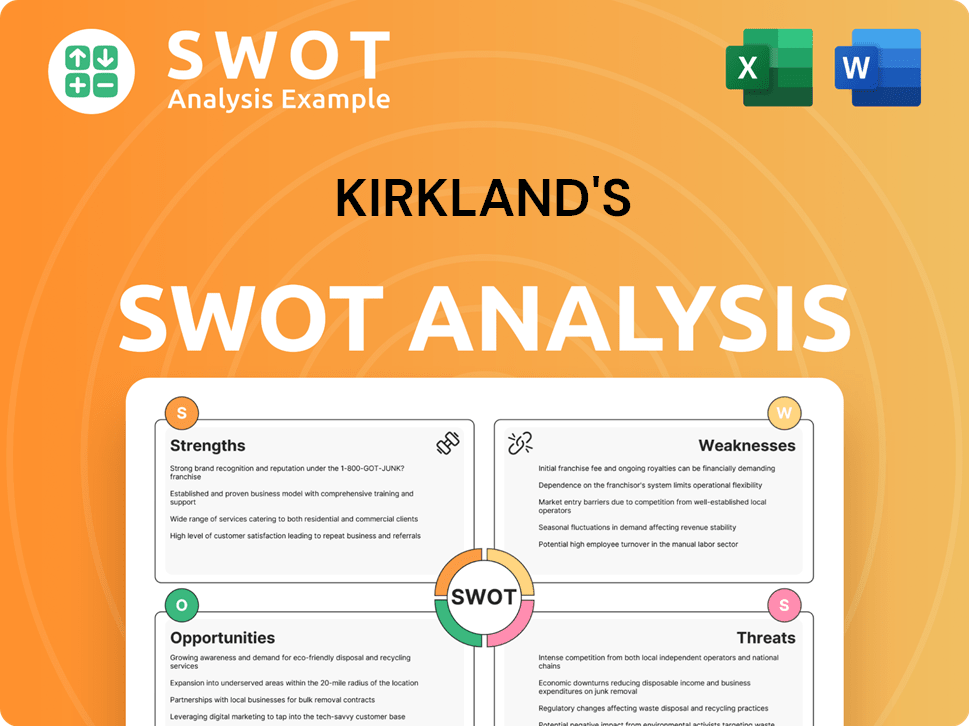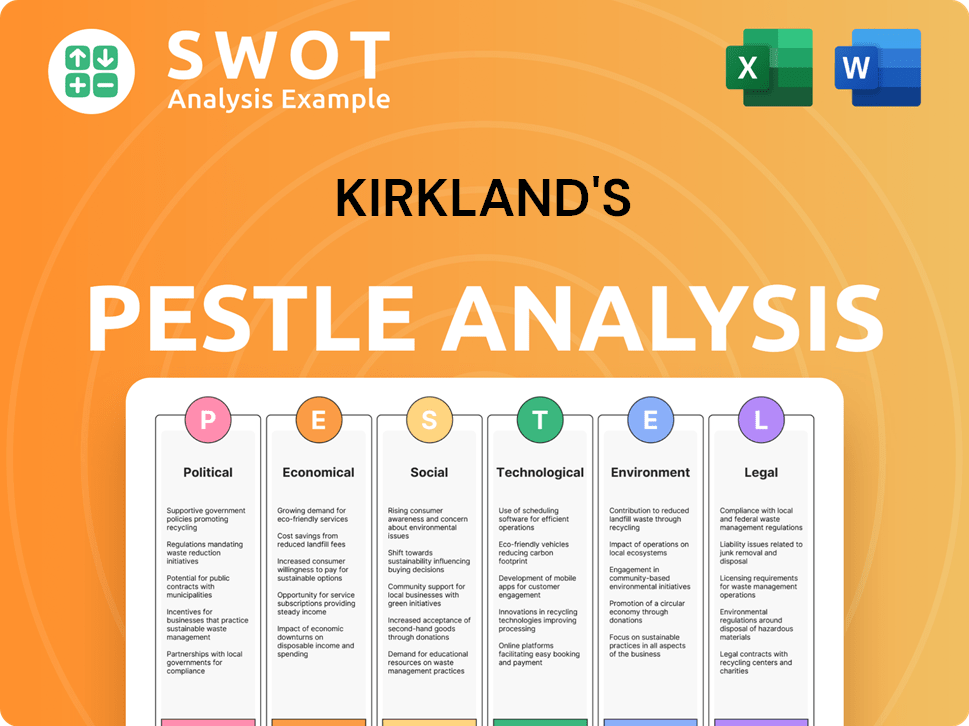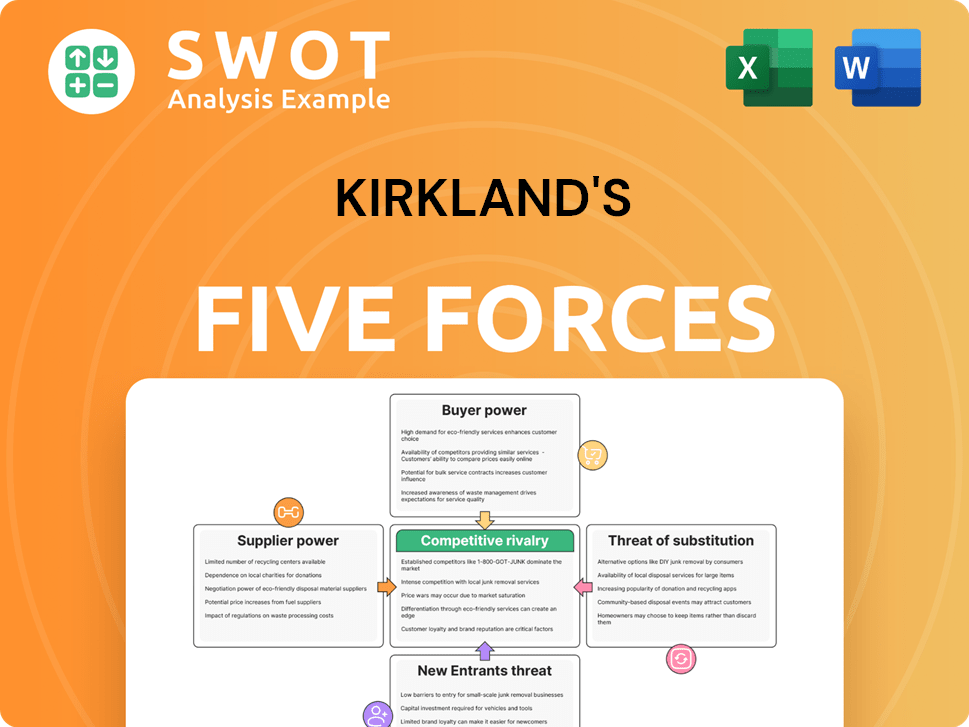Kirkland's Bundle
How is Kirkland's Redefining Retail in 2025?
In the ever-evolving home décor market, Kirkland's, Inc. is making significant strategic shifts. This article dives deep into Kirkland's sales strategy and marketing strategy, revealing how the company is adapting to maintain its competitive edge. Discover how Kirkland's is leveraging key partnerships and omnichannel strategies to navigate the dynamic retail landscape.

Kirkland's, a key player in the home goods sector, is currently focused on boosting its Kirkland's SWOT Analysis to refine its Kirkland's business model. The company's recent partnership with Beyond, Inc., including the integration of buybuy Baby stores, marks a pivotal moment in its growth strategy. This strategic move aims to enhance Kirkland's revenue streams and strengthen its position within its Kirkland's target market by improving its Kirkland's e-commerce sales strategy and overall sales performance analysis.
How Does Kirkland's Reach Its Customers?
The sales channels of Kirkland's, a home décor and furnishings retailer, are structured around an omnichannel approach. This strategy combines physical retail locations with a digital e-commerce platform to reach a wider customer base. As of May 1, 2025, the company operates a network of 314 stores across 35 states, complemented by its online presence at kirklands.com, operating under the Kirkland's Home brand.
This dual-channel approach reflects a strategic evolution. Initially, the company focused on brick-and-mortar stores, transitioning from in-mall locations to more accessible shopping centers in 2005. Recognizing the growing importance of digital retail, Kirkland's expanded into e-commerce in the early 2010s, aiming to create a seamless shopping experience for its customers. This strategic shift to an omnichannel retail strategy was designed to cater to evolving consumer preferences and enhance market reach.
The company's sales performance across these channels has varied. While brick-and-mortar comparable store sales saw positive growth, increasing by 1.6% in Q4 2024 and 1.9% for the full fiscal year 2024, e-commerce sales experienced a decline, dropping by 7.9% in Q4 2024 and 12.9% for the fiscal year 2024. This divergence underscores the company's ongoing efforts to optimize its digital sales strategy and overall sales performance analysis.
A significant strategic move was the October 2024 partnership with Beyond, Inc. This collaboration included a $25 million investment. This partnership aimed to drive consistent traffic and improve inventory turns.
Kirkland's utilizes both physical retail stores and an e-commerce platform. The physical stores saw positive growth in 2024, while e-commerce experienced a decline. This highlights the importance of adapting to market changes.
The company is actively working to improve its e-commerce performance. The decline in e-commerce sales in 2024 indicates the need for strategic adjustments. This includes leveraging partnerships and enhancing the online shopping experience.
The partnership with Beyond, Inc. aims to improve e-commerce performance. It includes the expansion of Kirkland's Home private label distribution. This strategic alliance is designed to boost sales.
Kirkland's sales strategy is centered on a dual-channel approach, combining physical stores and e-commerce. The company's focus on an omnichannel retail strategy is evident in its efforts to optimize both channels. The Beyond, Inc. partnership is a key element of this strategy.
- Brick-and-mortar sales showed positive growth in 2024.
- E-commerce sales experienced a decline in 2024.
- The Beyond, Inc. partnership aims to boost e-commerce.
- Kirkland's is working to improve its overall sales performance.
Kirkland's SWOT Analysis
- Complete SWOT Breakdown
- Fully Customizable
- Editable in Excel & Word
- Professional Formatting
- Investor-Ready Format

What Marketing Tactics Does Kirkland's Use?
The marketing tactics employed by the company are designed to boost brand awareness, generate leads, and drive sales. The current emphasis is on re-engaging its core customer base, refining product assortment, and strengthening omnichannel capabilities. The company's marketing strategy focuses on cost-effective methods and leveraging customer data profiles to maximize the impact of its marketing spending.
A key element of the company's approach involves a data-driven marketing strategy, with efforts to re-activate lapsed customers. The company is also focused on creating an engaging shopping experience within its physical stores, which serves as a marketing tool.
The company's marketing mix is evolving to prioritize efficiency, with a cost-cutting plan announced in June 2024. This plan includes reductions in marketing expenses, aiming for $6 million in savings in fiscal 2024 and $7 million in ongoing annual pre-tax savings.
The company's e-commerce platform, kirklands.com, is a crucial part of the customer journey. It is working to optimize e-commerce performance, including actions like eliminating SKUs that do not meet margin standards. The company is expanding product categories to drive average order value.
Over the 12 months leading up to Q2 2024, the company saw a 39% re-activation of lapsed customers. This was driven by a focus on seasonally-relevant, high-value décor. This highlights the importance of targeted marketing efforts and understanding customer behavior.
Recent reports do not detail extensive use of TV, radio, or print advertising. The company emphasizes an engaging shopping experience in its physical stores. The in-store environment itself serves as a marketing tool, aiming to provide a unique brand experience.
A cost-cutting plan announced in June 2024 includes reductions in marketing expenses. The company aims for $6 million in savings in fiscal 2024 and $7 million in ongoing annual pre-tax savings. This reflects a focus on efficiency and optimizing marketing spend.
The company is focused on strengthening omnichannel capabilities. This involves integrating the online and in-store experiences to provide a seamless customer journey. This approach is crucial for enhancing customer engagement and driving sales.
The company employs a data-driven approach to marketing. This includes building customer data profiles to maximize the reach and impact of its marketing spend. This data-driven strategy is essential for effective customer retention strategies and understanding the company's target market.
The company's marketing strategy focuses on a combination of digital and in-store tactics, emphasizing cost efficiency and customer re-engagement. The company's approach includes optimizing its e-commerce platform and creating an engaging in-store experience.
- E-commerce Optimization: Enhancing the online shopping experience and improving conversion rates.
- Customer Re-activation: Targeting lapsed customers with relevant offers.
- In-Store Experience: Creating a unique and engaging shopping environment.
- Cost Management: Reducing marketing expenses to improve profitability.
- Data Analysis: Utilizing customer data to inform marketing decisions.
For more details, you can read about the Revenue Streams & Business Model of Kirkland's.
Kirkland's PESTLE Analysis
- Covers All 6 PESTLE Categories
- No Research Needed – Save Hours of Work
- Built by Experts, Trusted by Consultants
- Instant Download, Ready to Use
- 100% Editable, Fully Customizable

How Is Kirkland's Positioned in the Market?
Kirkland's brand positioning centers on being a specialty retailer of home décor and furnishings, offering 'great style and great prices.' This positioning is designed to provide stylish and affordable solutions to its customers, focusing on value and design. The brand curates an assortment to deliver desired looks without requiring significant expense or extensive searching, setting it apart in the market.
The company's identity is built around providing an engaging shopping experience, characterized by a curated selection and inspirational design ideas, both in-store and online. This approach aims to attract and retain customers by offering a blend of quality merchandise, value pricing, and a stimulating shopping environment. The emphasis is on catering to diverse tastes and styles through a wide variety of products, including furniture, wall décor, decorative accessories, and seasonal goods.
Kirkland's maintains brand consistency across its physical stores and e-commerce platform. The retailer has adapted to shifts in consumer sentiment and competitive threats by implementing strategic initiatives to revitalize its brand. A recent partnership with Beyond, Inc., aims to maximize the brand value and distribution of Kirkland's Home, leveraging it as an exclusive private label assortment for everyday basics and décor in Bed Bath & Beyond stores, expanding its reach. This strategic move demonstrates the company's adaptability in a competitive home décor market, which is projected to reach $838.6 billion by 2027.
Kirkland's offers 'great style and great prices,' emphasizing value and design. This core message differentiates the brand by providing stylish and affordable home décor solutions. The focus is on delivering desired looks without significant expense, appealing to a broad customer base seeking quality at competitive prices.
The company targets a diverse audience seeking stylish, affordable home décor. The brand caters to various tastes and styles by offering a wide variety of products. The Target Market of Kirkland's includes customers looking for quality merchandise and an engaging shopping experience.
Kirkland's competitive advantage lies in its curated assortment and value pricing. Private label offerings, which represent 35% of total product inventory, help maintain competitive pricing and gross margins. The engaging shopping experience, both in-store and online, further enhances its appeal.
Brand consistency is maintained across physical stores and the e-commerce platform. Strategic initiatives, like the partnership with Beyond, Inc., aim to maximize brand value and distribution. This omnichannel approach ensures a cohesive brand experience, reinforcing customer loyalty and expanding market reach.
Kirkland's Business Model Canvas
- Complete 9-Block Business Model Canvas
- Effortlessly Communicate Your Business Strategy
- Investor-Ready BMC Format
- 100% Editable and Customizable
- Clear and Structured Layout

What Are Kirkland's’s Most Notable Campaigns?
The sales and marketing strategies of Kirkland's, particularly in 2024 and heading into 2025, are centered around key campaigns designed to revitalize the brand and drive growth. These initiatives are not isolated marketing campaigns but rather strategic pillars that guide the company's overall approach. The focus is on re-engaging the core customer base, optimizing product offerings, and strengthening omnichannel capabilities to enhance customer experience and drive sales.
A central element of Kirkland's sales strategy involves a data-driven approach to product selection, aiming to maximize profitability and customer satisfaction. This includes optimizing product categories and eliminating less profitable SKUs. The company's strategy also includes a renewed focus on seasonally-relevant, high-value décor, which has led to a 39% re-activation rate of lapsed customers over the 12 months leading up to Q2 2024, demonstrating successful customer retention strategies.
The company is also strengthening its omnichannel capabilities. A significant aspect of this strategy is the partnership with Beyond, Inc., announced in October 2024, which includes a $25 million investment. This strategic alliance represents a significant campaign to leverage partnerships for increased brand visibility and market share. The partnership aims to optimize online performance through Beyond's expertise, even though e-commerce sales declined by 7.9% in Q4 2024.
Kirkland's sales strategy includes re-engaging its core customer base. The company has focused on seasonally-relevant, high-value décor to reconnect with its established customer base. This approach led to a 39% re-activation rate of lapsed customers over the 12 months leading up to Q2 2024, demonstrating effective customer retention strategies.
Another key focus is refocusing product assortment. This involves optimizing product categories and eliminating less profitable SKUs, especially in the e-commerce channel. This data-driven approach aims to maximize profitability and customer satisfaction, contributing to Kirkland's revenue streams and overall growth strategy.
Strengthening omnichannel capabilities is a crucial part of Kirkland's marketing strategy. The partnership with Beyond, Inc., is a central component of this. The goal is to leverage partnerships for increased brand visibility and market share, aiming to address challenges in the digital space and improve the customer experience.
The Beyond, Inc. partnership is a significant campaign. It includes a $25 million investment and positions Kirkland's as the exclusive brick-and-mortar operator for Bed Bath & Beyond and buybuy Baby stores. This collaboration aims to drive traffic, improve inventory turns, and enhance store productivity, contributing to Kirkland's market share analysis.
Kirkland's sales strategy centers around several key initiatives designed to drive growth and enhance customer engagement. These initiatives are interconnected and work together to create a cohesive approach to the market. For more insights into the company's history, you can read a Brief History of Kirkland's.
- Re-engaging the Core Customer: Focusing on seasonally-relevant décor.
- Refocusing Product Assortment: Optimizing product categories.
- Strengthening Omnichannel Capabilities: Leveraging partnerships.
- Beyond, Inc. Partnership: A $25 million investment.
Kirkland's Porter's Five Forces Analysis
- Covers All 5 Competitive Forces in Detail
- Structured for Consultants, Students, and Founders
- 100% Editable in Microsoft Word & Excel
- Instant Digital Download – Use Immediately
- Compatible with Mac & PC – Fully Unlocked

Related Blogs
- What are Mission Vision & Core Values of Kirkland's Company?
- What is Competitive Landscape of Kirkland's Company?
- What is Growth Strategy and Future Prospects of Kirkland's Company?
- How Does Kirkland's Company Work?
- What is Brief History of Kirkland's Company?
- Who Owns Kirkland's Company?
- What is Customer Demographics and Target Market of Kirkland's Company?
Disclaimer
All information, articles, and product details provided on this website are for general informational and educational purposes only. We do not claim any ownership over, nor do we intend to infringe upon, any trademarks, copyrights, logos, brand names, or other intellectual property mentioned or depicted on this site. Such intellectual property remains the property of its respective owners, and any references here are made solely for identification or informational purposes, without implying any affiliation, endorsement, or partnership.
We make no representations or warranties, express or implied, regarding the accuracy, completeness, or suitability of any content or products presented. Nothing on this website should be construed as legal, tax, investment, financial, medical, or other professional advice. In addition, no part of this site—including articles or product references—constitutes a solicitation, recommendation, endorsement, advertisement, or offer to buy or sell any securities, franchises, or other financial instruments, particularly in jurisdictions where such activity would be unlawful.
All content is of a general nature and may not address the specific circumstances of any individual or entity. It is not a substitute for professional advice or services. Any actions you take based on the information provided here are strictly at your own risk. You accept full responsibility for any decisions or outcomes arising from your use of this website and agree to release us from any liability in connection with your use of, or reliance upon, the content or products found herein.